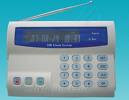 If you're considering home security, you should take a look at a wireless monitored home security system. More traditional burglar alarm and security systems had to be hard-wired into the home. They were expensive, difficult to install, and hard to repair.
If you're considering home security, you should take a look at a wireless monitored home security system. More traditional burglar alarm and security systems had to be hard-wired into the home. They were expensive, difficult to install, and hard to repair.A modern wireless monitored home security system has many advantages.
- easier and faster installation
- no elaborate cable or wiring
- anytime, anywhere home monitor
- lithium battery for power failures
- remote arm and disarm function
- camera coverage for large areas outside
- easy relocation
Using a wireless monitored home security system provides home and business owners with the ability to easily monitor activity in your home. Parents can go to work and keep an eye on children, babysitters, service workers, and repairmen. Imagine being able to dispute a repairman who claims to have done more than was needed! You can keep a watch on unattended pets. You can keep an eye on the back yard to monitor and catch young vandals.
You have many choices in selecting and configuring your wireless monitored home security system. You can use one or many cameras to cover the most vulnerable areas on your property. You can select cameras that operate well in low-light or infrared cameras that monitor dark areas.
Wireless monitored home security systems can serve many other purposes. Web cams are inexpensive and easy to set up. You can install a camera in the nursery to keep a watchful eye on the baby or in the garage to monitor hubby's progress on car repairs. You can use a camera in the playroom or den to be sure the kids aren't into mischief and the dog's not eating the sofa.
Most wireless monitored home security systems can accommodate up to 16 cameras, so you'll be assured of adequate video coverage of your property. And the system can be customized to meet your unique needs. For additional savings, many homeowners have chosen to buy a wireless home security kit. Unless you're tech-savvy, though, you should probably ask a professional to do the installation. Using equipment you purchased, installation should be affordable.
A standard wireless monitored home security kit sells for about $100 online and comes with many useful options. They include a range of multiple zone options, loud sirens with different tones for different types of emergency (for example, a different alarm for a burglar as for a fire). They also include both exterior and interior sensors, door and window chimes, and status indicators for visual images.
Accessories and add-ons on the market include rechargeable battery back-ups, smoke detectors, exterior sirens, voice dialers, glass break sensors, and subscriptions to monitoring services. While you can choose to monitor your home yourself, you may find that task overwhelming. You can't be available all the time to monitor your system, so it's a wise decision to subscribe to a home security service that can monitor your home for an affordable monthly fee.
When deciding how to configure your wireless monitored home security system, there are several things you should have decided. You'll need to know what areas in your home and on your property you want to monitor. Know what level of lighting you have and what types of cameras you'll need. Decide what areas you want to monitor and how many cameras it will take.
Then take your requirements to a wireless monitored home security specialist at local stores and ask for recommendations. Look at several brands and models to get a good comparison and to meet your needs at the lowest possible cost. When you know what you want, you can shop online for great deals. You can find a huge variety of wireless monitored home security systems at online stores and auction services.
One caution. Be sure your new wireless monitored home security system will not interfere with, or be interrupted by, other wireless equipment in your home. Wireless internet connections and cordless phones can reduce efficient and effective system operations. Be sure your wireless monitored home security system operates on a different frequency that will not compete with existing wireless equipment and appliances.








